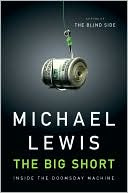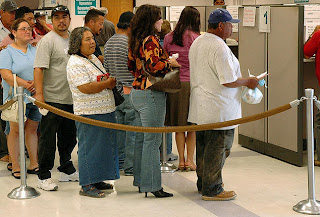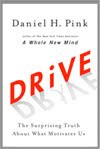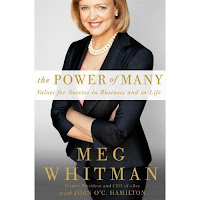More on Michael Lewis' Book
Reuters has a very interesting video q&a with Michael Lewis, now on its website. You can find it at: http://live.reuters.com/Event/Live_chat_with_Michael_Lewis
Eyesight to the Blind
Henry Paulson admits he didn’t see the meltdown coming. In his memoir On the Brink, the former Treasury Secretary describes a 2006 meeting of the White House economic team at Camp David, where he warned of the possibility of a coming economic “disruption,” which he said was overdue. But, he adds, “I misread the cause, and the scale, of the coming disaster. Notably absent from my presentation was any mention of problems in housing or mortgages.”
So if Paulson missed it, and Treasury Secretary to-be Timothy Geithner missed it, and Fed chairman Ben Bernanke missed it…who saw the cataclysm coming?
In the words of Michael Lewis, only a handful of unusual, “almost by definition odd” outsiders were able to look past the conventional wisdom and see the subprime-mortgage-inflated market for what it was. Lewis profiles this tiny group who were able to “see the ugly facts and respond to them” — and thereby make a killing even as most of Wall Street was decimated–in his new book, The Big Short: Inside the Doomsday Machine (Norton, $27.95). My review of this very informative and, believe it or not, entertaining book appears today on Reuters at http://blogs.reuters.com/great-debate/2010/03/11/michael-lewis-big-short-an-unsettling-experience/.
As is common with Lewis, there are some funny bits — but given the subject matter, the volume could hardly be a laugh riot. After all, fortunes were destroyed and many, many people were financially ruined. Still, consider this passage, where the author describes his protagonists’ hunt for the worst subprime-mortgage-backed bonds, which they were preparing to short: “Looking for bad bonds inside a CDO [or collateralized debt obligation] was like fishing for crap in a Port-O-Let: the question wasn’t whether you’d catch some but how quickly you’d be satisfied you’d caught enough.”
That’s typical of Lewis’s not-for-family-hour prose. Darkly funny stuff. And also highly insightful. For a writer who made his reputation on claims that he knew nothing about nothing when hired to work on Wall Street in the ’80s, somehow Lewis has learned a great deal about some very sophisticated investing.
Thinking About Change
Two themes have dominated the business-books scene in recent years: How people think and make decisions, and how people react to change. Not that these are unrelated. Much of what Corporate America’s managers and employees ponder is change—can we possibly implement this new top-down initiative? How will I be affected? What on earth is the boss contemplating?
Recent weeks have seen two more books added to an already impressive roster: Daniel Pink’s Drive: The Surprising Truth About What Motivates Us and surgeon Atul Gawande’s The Checklist Manifesto: How to Get Things Right. Both are riding high on best-seller lists. Now comes a third volume sure to join them there: Switch: How to Change Things When Change is Hard by Chip Heath and Dan Heath, authors of the 2007 best-seller Made to Stick.
It’s instructive to compare just these three. Pink addresses both managers and the rest of us with a research-laden volume aimed at undermining what he sees as institutions’ over reliance on money as a motivator. Gawande argues that a great many professional tasks have become too complicated to be managed by our little brains—and that a simple device, the checklist, can make a world of difference. So both of these accounts consider how our minds work and how particular alterations can make the world a better place.
The Heaths, on the other hand, advocate no particular change, although they offer a great many examples. Instead, like such previous assaults as Who Moved My Cheese? and Our Iceberg Is Melting, Switch assumes that people resist change and must be taught to like it. This book is not as offensive as some of the change-motivating fables—after all, it’s not really aimed at a presumed-to-be-stupid rank and file, but at presumed-to-be-intelligent managers. But unlike, say, The Checklist Manifesto, it’s not exactly a joy to read—nor does one come away feeling exhilarated and eager to take up the authors’ cause.
For my complete review of Switch, posted at AOL’s Daily Finance site, go to: http://www.dailyfinance.com/story/books-daily-finance-balancing-reason-and-emotion-in-business/19357960/
Let it Snow!
The heavy snow on the Eastern seaboard has meant lots of downtime for Washington, D.C. workers and even some for New York and New Jersey folks. As we enter the President’s Day weekend, I notice I’m getting lots of “Out of the Office” responses to my e-mails. Having had no choice but to take several days off this week already, some people are out today and only returing to work on Tuesday…which makes me think.
When you’re unemployed, you never really have a day off–or alternately, every day is a day off. It’s a weird feeling: You know that every day, including weekends, you should be doing something regarding a job search. But what? Already this week, I’ve had an electronic-resume workshop canceled…thanks to forecast “inclement weather.” Don’t these people know that I need their help? And, now with the rest of the world being out-of-pocket, schussing down the slopes or out to Valentine’s Day dinners, there’s no way they’ll be giving my e-mailed resume the scrutiny it deserves.
Oh, let it snow some more! Away with all work and work-less cares!
The Perils of Paulson
When is a has-been NOT a has-been?
When is history NOT simply written by the winners?
Answer: When the subject is economics or the weather. The consequences of both those phenomena live on and on, and the interpreters–whether they be Alan Greenspan or Al Roker–get to talk on and on, into the indefinite future. “Yeah, well I didn’t exactly predict what happened…BUT…”
There’s still plenty of controversy over the actions taken by the government in the fall of 2008, when the Meltdown was in Flower. (Mixed metaphors are such fun.) Witness the third degrees recently doled out by Congress to both current and former Treasury Secretaries Timothy Geithner and Henry Paulson.
Paulson’s hardcover retelling of events is now available in bookstores. For my take on it, go to:
http://www.dailyfinance.com/story/books-dailyfinance-henry-paulsons-meltdown-memoir/19341930/
It’s an interesting book, with multiple revelations about the likes of FDIC chair Sheila Bair (who Paulson says was willing to see Citigroup die), numerous Senators and Congresspeople, and about Paulson himself. When the going got tough, as at various Congressional hearings, Paulson reveals that he tended to have the “dry heaves” and had to excuse himself from the room. The Treasury Secretary also shows himself to be a religious man and often depended upon the power of prayer to get him through.
If you’re angry at the insiders who managed the bailout, TARP, and the takeover of Freddie Mac and Fannie Mae, you might look at Paulson’s volume. It’ll make you feel some sympathy for just what these people put themselves through to save the system.
On the Scene: the Unemployment Office
I could tell who she was at a glance: a former journalist, now unemployed. One question confirmed it—“where did you work?” InStyle, she said, referring to the Time Inc. fashion-and-celebrity magazine. Time has had waves of layoffs like so many other media companies. And it turned out, the room was full of similar people, from InStyle, Gourmet, and, of course, BusinessWeek.
Site: the unemployment office. The New York State Department of Labor had summoned me there, via a threatening, computer-generated note. I anticipated a grilling, connected to some failure on my part, real or bureaucrat-invented. Turns out, everyone receiving unemployment benefits has to report for an “orientation session.” Happily, the Kafkaesque elements of the meeting were kept to a minimum, and department representatives even offered a bit of self-deprecating humor about how long a telephone caller might have to wait before speaking to a live person.
I thought again about this experience as I examined a posting on the New York Times site–a fascinating, action chart called “The Jobless Rate for People Like You”
As you click on variables such as race, gender, age, and education level, the graf line jumps – very notably, for example, for black men under the age of 25 who lack a high-school diploma, for whom the rate is nearly 50%. My group—white, male college grads over the age of 45—have a relatively low rate of unemployment, namely under 10%.
I don’t doubt that the last figure is at least somewhat accurate. Nevertheless, the “restructuring” going on in the field of journalism is having profound consequences for former scribblers, many of whom are casting about in other fields of work. I’ll be keeping you posted regarding my own job search and the adventures I encounter on the way.
Meanwhile, the Rutgers alumni magazine (Winter, 2010) carries a sobering piece, based on a survey conducted by that university’s John J. Heldich Center for Workforce Development. Among the recently unemployed, the survey shows, 84% received no severance package, 60% received no warning that they were about to lose their jobs, and 53% have received no unemployment benefits. Those who have gotten such bennies must count themselves lucky.
Further review coverage of Daniel Pink's "Drive"
I’ve been advised that I could provide a useful service by aggregating reviews of recent books. So, at the risk of seeming to be flacking for certain titles, that’s what I will begin doing. So far, I haven’t seen a lot of negative coverage of Dan Pink’s Drive — but I will be sure to include such pans if they appear.
In a Time interview with writer Kristi Oloffson, Pink opines that some employers have resisted his ideas since “there’s this idea that employees have to be monitored, that if you let them have any kind of autonomy they’re going to slack off.” To read the interview go to http://www.time.com/time/business/article/0,8599,1952993,00.html
And writing for Forbes.com, George Anders questions whether Pink’s proposals are appropriate for every kind of work — specifically mentioning supermarket clerks and mall cops. But Anders concludes that Pink’s ideas “deserve a wide hearing” and suggests that corporate boards “could do well by kicking out their pay consultants for an hour and reading Pink’s conclusions instead.” You can check out his column at: http://www.forbes.com/2010/01/12/daniel-pink-motivation-drive-workforce-opinions-book-review-george-anders.html
That’s Anders’ take–what’s yours? Several readers got into a heated back-and-forth after reading my Fortune.com article on Drive. One reader said he’d turned down a pay increase in exchange for greater vacation time. What do you think–is money still the primary motivator, or are you looking for something else in a work experience?
Why Carrots and Sticks Are Suddenly Passe
Daniel Pink’s just-published book, Drive: The Surprising Truth About What Motivates Us (Riverhead Books) is beginning to get some attention. Credit the former Al Gore speechwriter (and author of the bestselling A Whole New Mind) with leveling a blow at “pay for performance” schemes at the precise moment when big bonuses are sooooooo unfashionable. Pink says that, provided people have a baseline level of pay, what really moves them toward high levels of performance are such factors as autonomy on the job, mastery over a craft, and a sense of contributing to a higher purpose.
Stanford B-school professor Robert Sutton believes Pink “does a masterful job of showing the limits and drawbacks of widely accepted assumptions about motivation–showing the limits of carrots and sticks.” (To read Sutton’s comments, go to: http://bobsutton.typepad.com/my_weblog/2009/12/drive-daniel-pinks-definitive-and-fun-guide-to-motivation.html)
On The Wall Street Journal’s website, Barbara Chai quotes Pink as recommending that people look for personal motivation–their “third drive”—by considering things they do for fun. “Think about whether you can make a living doing that,” says Pink. “It’s more possible than people think.” (Go to http://online.wsj.com/article/SB10001424052748704152804574628230428869074.html
My own take is recorded today on the Fortune.com website at http://money.cnn.com/2010/01/07/news/daniel_pink.fortune/index.htm
An NPR “Talk of the Nation” spot with Pink can be heard at: http://www.npr.org/templates/story/story.php?storyId=122221202&ft=1&f=5
As I cast about for further writing gigs, let me offer a New Year’s wish that baseline pay doesn’t become passé. A Los Angeles Times article details the woeful situation now facing freelance writers: http://www.latimes.com/entertainment/news/la-et-onthemedia6-2010jan06,0,2787168.column
Coming in January and February
…are several business(y) books of note: The most-eagerly awaited (certainly by Random House) is former eBay CEO Meg Whitman’s The Power of Many: Values for Success in Business and in Life (Crown). The would-be California Gov tells all about work-family balance, the purchase by eBay of of PayPal, and lessons she learned working at Procter & Gamble, Bain, Stride Rite, and, very interestingly, at FTD. Values, schmaluuus–the worth of this volume is in its stories, not its “rules” for business. Still, I came away persuaded that it would be cool to have a chat with Meg. (Pub date: Jan. 26)
Switch: How to Change Things When Change is Hard by Chip Heath and Dan Heath (Broadway). So you liked Made to Stick, that Malcolm Gladwell-ish prescription for how successful products attract fans? Then, Switch may be for you: More tales about how our brains are constructed, with supporting evidence drawn from such sources as Save the Children and BP. (Pub date: Feb 16)
And speaking of brains, there’s Drive: The Surprising Truth About What Motivates Us by former Al Gore speechwriter and best-selling author Daniel Pink (Riverhead Books). You like to get paid–lots–for your work? Think about it: Pink surveys a variety of scientific experiments and corporate experiences that point to other factors as more significant in motivating workers. It’s all about “autonomy, mastery, and purpose,” he says–and makes us readers believe it. Put down your whips and your carrots, Mr. Bossman–what matters is getting your colleagues to apply a sense of play and imagination to their daily tasks. (Pub date: January 4).








